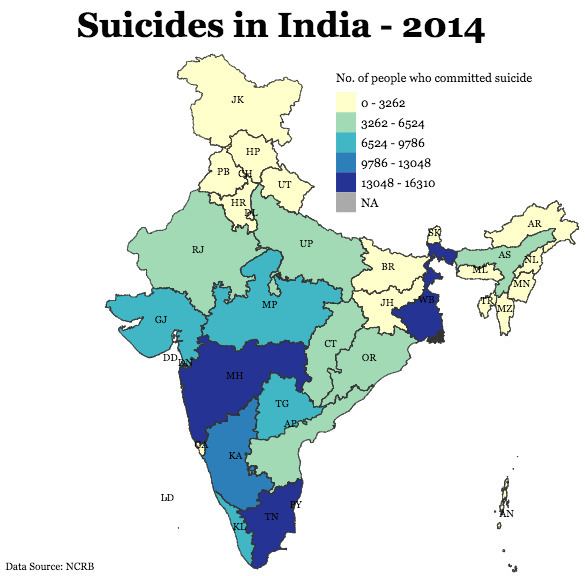 | ||
About 800000 people commit suicide worldwide every year, of these 135,000 (17%) are residents of India, a nation with 17.5% of world population. Between 1987 and 2007, the suicide rate increased from 7.9 to 10.3 per 100,000, with higher suicide rates in southern and eastern states of India. In 2012, Tamil Nadu (12.5% of all suicides), Maharashtra (11.9%) and West Bengal (11.0%) had the highest proportion of suicides. Among large population states, Tamil Nadu and Kerala had the highest suicide rates per 100,000 people in 2012. The male to female suicide ratio has been about 2:1.
Contents
- Definition
- Regional trends
- Age and suicide in India
- Method of suicide in India
- Literacy
- Suicide in cities
- Gender
- Domestic violence
- Suicide motivated by politics
- Suicide motivated by mental illness
- Farmers suicide in India
- Legislation
- Four pronged attack for suicide prevention
- References
Estimates for number of suicides in India vary. For example, one study projected 187,000 suicides in India in 2010, while official data by the Government of India claims 134,600 suicides in 2010.
According to WHO data, the age standardized suicide rate in India is 16.4 per 100,000 for women (6th highest in the world) and 25.8 for men (ranking 22nd).
Definition
The Government of India classifies a death as suicide if it meets the following three criteria:
If one of these criterion is not met, the death may be classified as death because of illness, murder or in another statistical .
Regional trends
The southern states of Kerala, Karnataka, Andhra Pradesh and Tamil Nadu along with eastern state of West Bengal, Tripura and Mizoram have a suicide rate of greater than 16 while in the Northern States of Punjab, Uttar Pradesh and Bihar, the suicide rate is less than 4. Puducherry reported the highest suicide rate at 36.8 per 100,000 people, followed by Sikkim, Tamil Nadu and Kerala. The lowest suicide rates were reported in Bihar (0.8 per 100,000), followed by Nagaland, then Manipur.
Age and suicide in India
In India, about 46,000 suicides occurred each in 15–29 and 30–44 age groups in 2012 – or about 34% each of all suicides.
Method of suicide in India
Poisoning (33%), hanging (38%) and self-immolation (9%) were the primary methods used to commit suicide in 2012.
Literacy
80% of the suicide victims were literate, higher than the national average literacy rate of 74%.
Suicide in cities
There were 19,120 suicides in India's largest 53 cities. In the year 2012, Chennai reported the highest total number of suicides at 2,183, followed by Bengaluru (1,989), Delhi (1,397) and Mumbai (1,296). Jabalpur (Madhya Pradesh) followed by Kollam (Kerala) reported the highest rate of suicides 45.1 and 40.5 per 100,000 people respectively, about 4 times higher than national average rate. There is a wide variation in suicide rates, year to year, among Indian cities.
Gender
On average, males suicide rate is twice that of females in India. However, there is a wide variation in this ratio at the regional level. West Bengal reported 6,277 female suicides, the highest amongst all states of India, and a ratio of male to female suicides at 4:3.
Domestic violence
Domestic violence is a major risk factor for suicide in a study in Bangalore. However, as a fraction of total suicides, violence against women – such as domestic violence, rape, incest and dowry – accounted for less than 4% of total suicides.
Suicide motivated by politics
Suicides motivated by ideology doubled between 2006 and 2008.
Suicide motivated by mental illness
The Indian government has been criticized by the media for its mental health care system, which is linked to the high suicide rate.
Farmer's suicide in India
India's economy vastly depends on agriculture with around 60% of its people directly or indirectly depend upon it. Different reasons like droughts, lack of better prices, exploitation by Middlemen, inability to pay loans etc. lead Indian farmers to suicide.
Legislation
In India, suicide was illegal and the survivor would face jail term of up to one year and fine under Section 309 of the Indian Penal Code. However, the government of India decided to repeal the law in 2014.
Four pronged attack for suicide prevention
A four pronged attack to combat suicide suggested in a 2003 monograph was (1) reducing social isolation, (2) preventing social disintegration, and (3) treating mental disorders. (4) Banning of pesticides & ropes
Additionally, a set of state led policies are being enforced to decrease the high suicide rate among farmers of Karnataka
